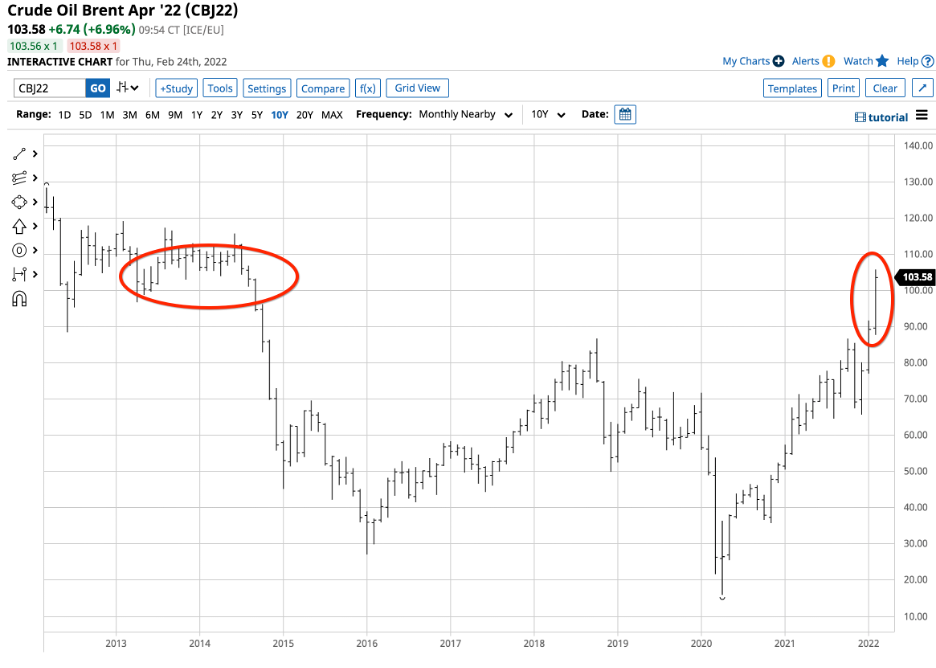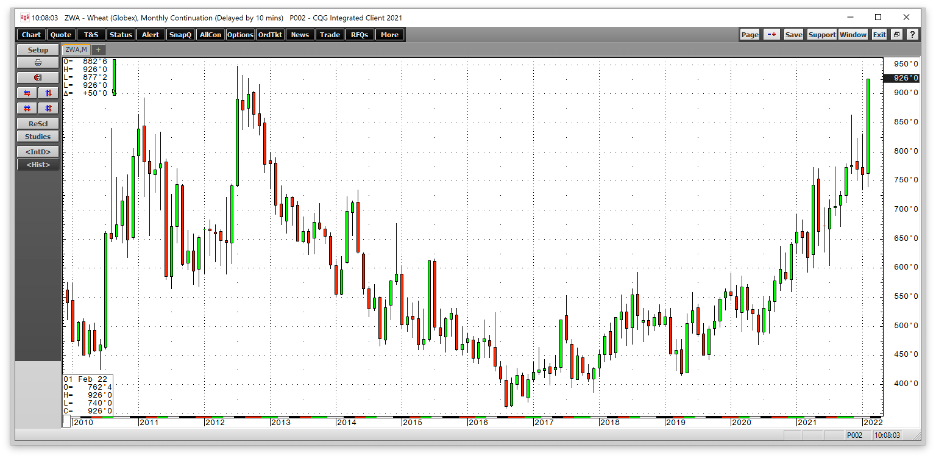This article was written exclusively for Investing.com
- President Putin makes a move
- The Russian sphere of influence continues to expand
- Crude oil, natural gas, and wheat supplies depend on Russia
- Platinum group metals, aluminum, fertilizers, and other commodities come from President Putin’s Russia
- Trade embargos, sanctions, and war distort the fundamental supply and demand equation for commodities
Commodities are global assets. Production occurs in regions where metals, minerals, and energy reserves are in the earth’s crust. Agricultural products come from areas where the climate, water supplies, and soil support crop growth. Consumption is ubiquitous, as all businesses and the over 7.877 billion people that inhabit our planet require raw materials, which are essentials for daily life, powering lives and providing nutrition and shelter.
Commodity prices reflect the economic and geopolitical landscapes, and geopolitical turmoil can impact prices dramatically. Not since the Cold War or perhaps the Cuban Missile Crisis in the early 1960s has two of the world’s leading nuclear powers faced off in a conflict situation. While Russia and the US were on the same side in World War II, the last major European conflict; the current Ukraine crisis poses a significant threat to world peace in early 2022. On Feb. 24, Russian President Vladimir Putin sent approximately 190,000 Russian troops across Ukraine’s border in a move that shocked the world.
The incursion will ripple through the global commodity markets like a tsunami causing price distortions in raw materials and markets across all asset classes.
President Putin makes a move
On Feb. 21, Russian President Putin spoke to his country and the world, justifying his reasoning for moving troops into Ukraine despite NATO’s objections. President Putin never considered Ukraine a sovereign nation. In 2008, he told US President George W. Bush, “George, you have to understand Ukraine is not even a country. Part of its territory is in Eastern Europe, and the greater part was given to us.” The Russians recognized the independence of two separatist regions in Donbas; the area, including Donetsk and Luhansk, has suffered under fighting between the Ukrainian government and Russian-backed rebels.
The Russian leader claimed that Ukraine remains an integral part of Russia and that NATO expansion threatens his country. In the aftermath of his speech, the Russian military rolled into Eastern Ukraine. The US and NATO consider the move an invasion and leveled the first round of sanctions on Russia, keeping more in their pockets if President Putin continues to move west towards the capital, Kyiv. On Feb. 24, Russian forces launched a full-scale attack on all of the major Ukrainian cities.
The Russian sphere of influence continues to expand
The move into Ukraine is not the first overt move the Russian have made to control regions previously part of the USSR. In 2008, Russia took control of Georgia. In 2014, the Russian military invaded and subsequently annexed the Crimean Peninsula, taking it from Ukraine.
In his Feb. 21 speech, President Putin cited NATO expansion that threatens Russia as the reason for sending “peace-keeping” troops into Ukraine to protect Russia from the hostile US and NATO. If success breeds success, the Russian leader could continue to reverse the dismantling of the Soviet Union.
Meanwhile, President Putin has expanded his sphere of influence in other regions. His support for Syria and Iran has been on the other side of the battle lines from the United States. In 2016, the Russians became the most influential nonmember of the international oil cartel. Today, OPEC is OPEC+ with no production decisions made without consultation and agreement from Moscow. With the US addressing climate change through supporting alternative and renewable energy sources at the expense of fossil fuels, the pricing power in the worldwide petroleum market is now in the hands of the cartel, with Russia in a leadership role, despite its status as a nonmember.
At the 2022 Winter Olympics in Beijing, President Putin and President Xi agreed on mutual support that could make US and European sanctions toothless over the coming weeks and months. The bottom line is the Russian leader has expanded his base of support and power via unchallenged military actions and strategically planned alliances in the Middle East and Asia.
Crude oil, natural gas, and wheat supplies depend on Russia
Russia is one of the top producers and exporters of crude oil and natural gas worldwide. Russian influence in OPEC policy only enhances its power in the energy markets.
Inflation and the US energy policy shift have already pushed oil’s price higher. The Brent benchmark is the pricing mechanism for approximately two-thirds of the world’s oil production and consumption.
Source: Barchart
Brent crude oil futures were already above the $90 per barrel level when Russian troops rolled into Eastern Ukraine on Feb. 22. In the aftermath of the full-scale invasion, Brent futures rose to a high of $105.79 per barrel. US President Biden has asked OPEC member Saudi Arabia to increase production three times since 2021, and the Saudis have refused on each occasion. The Russian invasion of Ukraine and the sanctions by the US and European countries could push crude oil prices to challenge the all-time high from 2007 at nearly $150 per barrel.
Europe depends on Russia for natural gas supplies. Sanctions are likely to cause disruptions as Russia uses the energy commodity as a political tool to counter economic sanctions. The US may look to divert LNG shipments from Asia to Europe to alleviate the shortages caused by Russia-NATO tensions. While the NYMEX natural gas futures market is primarily domestic, LNG shipments abroad have made it more of an international market. The situation in Ukraine is only enhancing the natural gas futures market’s sensitivity to the geopolitical landscape.
Source: Barchart
The monthly chart illustrates that nearby MYMEX natural gas futures were sitting above the $4.80 per MMBtu level on Feb. 24. While they have declined from the spike to a high of $7.346 in January, they remain well above the February 2021 high of $3.316 per MMBtu as the natural gas market approaches the historically weak beginning of the 2022 injection season.
While crude oil and natural gas provide power, wheat is the critical ingredient for nutrition. Russia is the world’s leading wheat exporting country.
Source: Barchart
The monthly chart of CBOT soft red winter wheat futures, the benchmark for world wheat prices, shows that the grain was trading at over the $9.25 per bushel level on Feb. 24. In February 2021, the high was at $6.8350 per bushel.
Wheat prices are rising because of the tensions with Russia and because the Black Sea Ports are in the region where military actions are commencing. Moreover, Ukraine is an influential wheat producer, and war in Ukraine threatens the 2022 wheat crop as acreage could become battlefields.
Platinum group metals, aluminum, fertilizers, and other commodities come from President Putin’s Russia
Russia is a leading producer of platinum, palladium, rhodium, and other platinum group metals. The metals are byproducts of Siberian nickel production from the Norilsk region, and Russia also supplies substantial levels of nickel and aluminum, critical base metals. Fertilizers, the inputs in worldwide agricultural production, are also produced in Russia.
Russia is a commodities powerhouse, with energy, metals, minerals, agricultural, petrochemical, and other exports supplying the world, including the US and Europe. Russia’s invasion of Ukraine threatens supply shortages at a time when inflation and supply chain bottlenecks have already lifted prices to multi-year and, in some cases, all-time highs.
Trade embargos, sanctions, and war distort the fundamental supply and demand equation for commodities
The US and Europe will protest the Russian invasion of Ukraine with harsh economic sanctions. The NATO members have promised President Putin debilitating sanctions that will impact Russia’s economy, cutting off foreign exchange flows. At the same time, Russia could impose crippling trade embargos, causing supply shortages in many critical commodity markets. War and sanctions will distort commodity prices and availabilities over the coming months as they impact the supply and demand equations.
Meanwhile, expect freight rates to rise as the insurance market will become prohibitive because of the potential for hostilities on the open seas. Russia’s move to take on the US and Europe could also cause a chain of events, including a Chinese move to reunify with Taiwan and more hostile actions from North Korea and Iran as they sense weakness from the West.
The Russian move into Ukraine comes as inflation is at the highest level in over four decades, and pandemic-related supply chain bottlenecks have caused commodity prices to rise. Ukraine is fuel for the commodity bull market, which could go into overdrive on the upside over the coming weeks and months.
